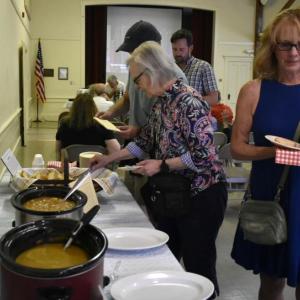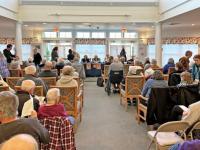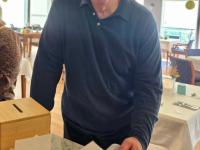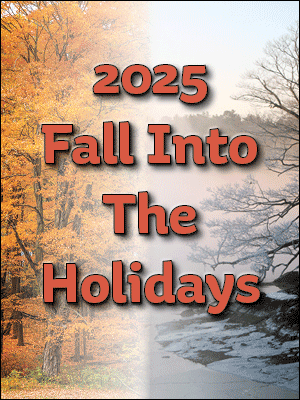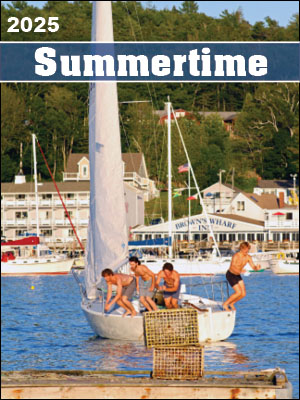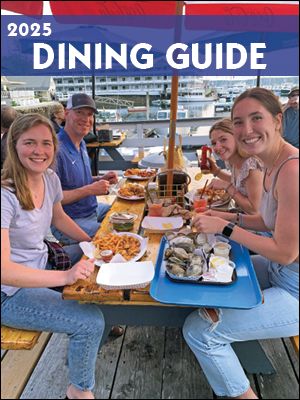Cookbooks: A glimpse through thyme
 Attendees' tastebuds get a blast to the past with historical New England recipes at Friends of the Southport Historical Society's latest lecture. ISABELLE CURTIS/Boothbay Register
Attendees' tastebuds get a blast to the past with historical New England recipes at Friends of the Southport Historical Society's latest lecture. ISABELLE CURTIS/Boothbay Register Speaker Marieke Van Der Steenhoven talks decoding the historical evidence found in cookbooks. ISABELLE CURTIS/Boothbay Register
Speaker Marieke Van Der Steenhoven talks decoding the historical evidence found in cookbooks. ISABELLE CURTIS/Boothbay Register Ale bread, made from an 18th century recipe, was a crowd favorite. ISABELLE CURTIS/Boothbay Register
Ale bread, made from an 18th century recipe, was a crowd favorite. ISABELLE CURTIS/Boothbay Register ISABELLE CURTIS/Boothbay Register
ISABELLE CURTIS/Boothbay Register ISABELLE CURTIS/Boothbay Register
ISABELLE CURTIS/Boothbay Register ISABELLE CURTIS/Boothbay Register
ISABELLE CURTIS/Boothbay Register ISABELLE CURTIS/Boothbay Register
ISABELLE CURTIS/Boothbay Register ISABELLE CURTIS/Boothbay Register
ISABELLE CURTIS/Boothbay Register ISABELLE CURTIS/Boothbay Register
ISABELLE CURTIS/Boothbay Register ISABELLE CURTIS/Boothbay Register
ISABELLE CURTIS/Boothbay Register ISABELLE CURTIS/Boothbay Register
ISABELLE CURTIS/Boothbay Register ISABELLE CURTIS/Boothbay Register
ISABELLE CURTIS/Boothbay Register Attendees' tastebuds get a blast to the past with historical New England recipes at Friends of the Southport Historical Society's latest lecture. ISABELLE CURTIS/Boothbay Register
Attendees' tastebuds get a blast to the past with historical New England recipes at Friends of the Southport Historical Society's latest lecture. ISABELLE CURTIS/Boothbay Register Speaker Marieke Van Der Steenhoven talks decoding the historical evidence found in cookbooks. ISABELLE CURTIS/Boothbay Register
Speaker Marieke Van Der Steenhoven talks decoding the historical evidence found in cookbooks. ISABELLE CURTIS/Boothbay Register Ale bread, made from an 18th century recipe, was a crowd favorite. ISABELLE CURTIS/Boothbay Register
Ale bread, made from an 18th century recipe, was a crowd favorite. ISABELLE CURTIS/Boothbay Register ISABELLE CURTIS/Boothbay Register
ISABELLE CURTIS/Boothbay Register ISABELLE CURTIS/Boothbay Register
ISABELLE CURTIS/Boothbay Register ISABELLE CURTIS/Boothbay Register
ISABELLE CURTIS/Boothbay Register ISABELLE CURTIS/Boothbay Register
ISABELLE CURTIS/Boothbay Register ISABELLE CURTIS/Boothbay Register
ISABELLE CURTIS/Boothbay Register ISABELLE CURTIS/Boothbay Register
ISABELLE CURTIS/Boothbay Register ISABELLE CURTIS/Boothbay Register
ISABELLE CURTIS/Boothbay Register ISABELLE CURTIS/Boothbay Register
ISABELLE CURTIS/Boothbay Register ISABELLE CURTIS/Boothbay Register
ISABELLE CURTIS/Boothbay RegisterWhether it was food or knowledge you were craving, Friends of the Southport Historical Society served up a satisfying dish. Southport Town Hall was packed Aug. 4 for the group’s latest installment of the Donald and Joyce Duncan Lecture Series, “Cookbooks as Historical Evidence,” led by Marieke Van Der Steenhoven, Bowdoin College's Special Collections Education and Engagement librarian.
Guests got to sample select 18th and 19th century recipes pulled from historical cookbooks and perfected by Sigrid Kopf over months, including gourd soup (1832), fish stew (1830), ale bread (1760) — made with yeast donated from Boothbay Craft Brewery — and barley sugar candy (1702). Vintage cookware from Hendricks Hill Museum was on display.
“I can't think of a better atmosphere ... There is nothing more magical than talking about cookbooks with the smell of food in the air,” said Van Der Steenhoven.
Van Der Steenhoven discussed Bowdoin’s Esta Kramer Collection of American Cookery, which contains 700 cookbooks, from the 1700s to the 1960s. She broke down three methods by which cookbooks can be interpreted: the book's physical attributes; the paratext (titles, prefaces, illustrations, annotations, etc.); and the form and content of the recipes.
For instance, the size of a book can tell historians about its usage. Was it small enough to fit in an apron pocket, implying practical use? Or, as often found with modern-day celebrity chef books, was it large and unwieldy, making it a better display item?
“Cookbooks can tell us much more than just what to eat and how to cook it. (They) speak in stereo to American cuisine and American culture, cookbooks document food as it flourished and floundered through major social movements and historical events.”
Ingredients reveal what was widely available at the time, showing the everyday impact of trade, colonization and industrialization. As for the recipes, most relied on assumed knowledge. A clove cake recipe from The New England Economical Housekeeper, and Family Receipt Book (1845), in its entirety reads: “Three pounds of flour, one of butter, one of sugar, three of eggs, two spoonfuls of cloves. Mix it with molasses.”
How much molasses? How long should it be baked? That’s left up to the reader.
While the recipes are lacking in detail, that can’t be said for the titles. The full name of the first cookbook published in Maine was “Fish, flesh, and fowl: a book of recipes for cooking, compiled by Ladies of State Street Parish. Each recipe contained in this book has been thoroughly tested and proved good (1877).” And that’s not the longest one Van Der Steenhoven shared.
But the name shows another important aspect of cookbook history: the dominance of female authors when women were otherwise often absent from the publishing scene. According to Van Der Steenhoven, women's groups also began selling charitable community cookbooks to raise funds for victims during the Civil War.
From then until World War I, more than 5,000 such books were printed for causes that included women’s suffrage, temperance, orphanages, schools, libraries, hospitals, churches and more. “Fish, flesh and fowl” was published to raise funds for the local parish.
“This exemplifies a trend that begins in the 19th century of American cookbook publishing scene, the domination of the field by influential and knowledgeable women who were not only recognized culinary authorities, but were also active in major cultural and societal concerns over time.”
This backbone of female expertise and the growing marketability of domesticity is what laid the groundwork for later cults of personality, such as Julia Child.
The next lecture is “An Evening of Tales” with retired bridge tenders Duane and Dwight Lewis, Aug. 11 at 7 p.m. at Southport Town Hall.

